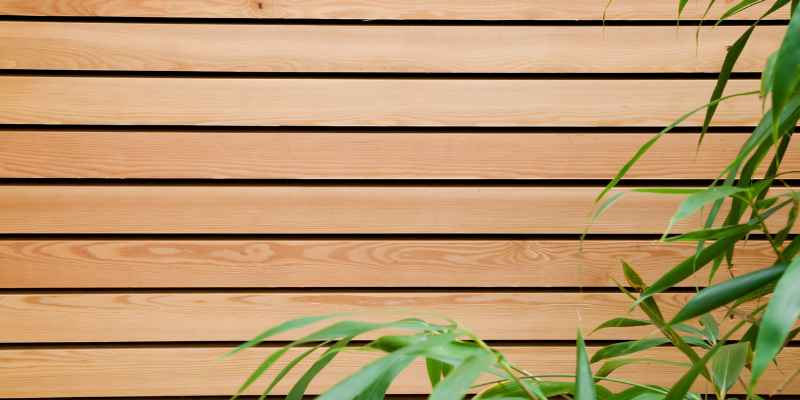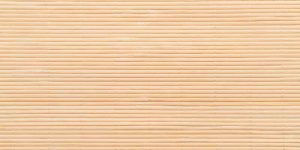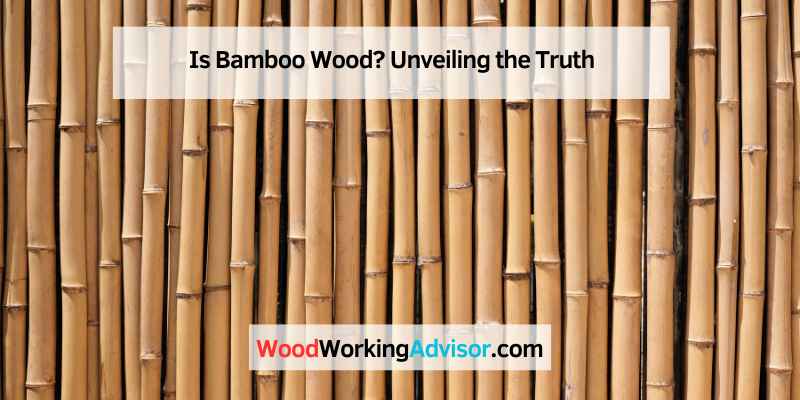No, bamboo is not a type of wood; it is classified as a grass species with unique properties. Bamboo, with its fast growth and strength, is a sustainable and economic alternative to traditional wood in various industries such as construction and furniture production.
Its classification as a grass, rather than wood, allows for a deeper understanding of its composition and growth pattern. Despite often being used in products akin to wood, bamboo differs significantly in its fiber structure, providing durability and strength. This distinction makes bamboo a versatile and eco-friendly material choice in today’s market, offering a range of benefits for both manufacturers and consumers alike.
Is Bamboo Wood?
Is Bamboo Wood? Bamboo, though often used similarly to wood in furniture and flooring, is not classified as wood. Instead, bamboo is a type of grass, offering a unique composition and growth pattern distinct from traditional tree wood.
Bamboo Classification As Wood
Bamboo falls under the classification of Liliopsida, which includes the lily flower. Moreover, bamboo belongs to the Poaceae family, also known as the grass family. This classification distinguishes bamboo as a distinctive plant species.
Bamboo’s Unique Material Composition
Bamboo is neither hardwood nor softwood; rather, it is derived from a grass variety known as giant bamboo Moso. The bamboo stem is harvested and utilized in creating a durable material. The densely packed fibers of bamboo contribute to its exceptional strength and sustainability.
Bamboo Vs. Wood
When it comes to building materials, bamboo and wood are two popular choices that are often compared. While wood has been used for centuries in construction and furniture production, bamboo is gaining popularity as a sustainable and economic alternative. In this article, we will explore the differences between bamboo and wood, from material properties to environmental impact and sustainability.
Differences In Material Properties
One of the main differences between bamboo and wood lies in their material properties. Wood is derived from trees, which are classified as hardwood or softwood based on their characteristics. Hardwoods, such as oak and mahogany, are known for their density and durability, while softwoods, such as pine and cedar, are lighter and more easily worked with.
On the other hand, bamboo is not classified as wood but as a type of grass. Despite this classification, bamboo shares some similarities with wood due to its composition. Bamboo is made up of densely packed fibers, giving it a unique strength and durability comparable to hardwood. This makes bamboo a suitable material for construction and furniture production.
Another notable difference in material properties is the growth pattern of bamboo and wood. Wood comes from trees that grow vertically, resulting in long, cylindrical trunks. Bamboo, however, grows in clusters and has segmented stems. This growth pattern gives bamboo its characteristic hollow and cylindrical shape.
Environmental Impact And Sustainability
When it comes to environmental impact and sustainability, bamboo shines as a more eco-friendly choice compared to wood. Bamboo has a fast growth rate, reaching maturity in 3 to 5 years, whereas trees used for wood can take decades to reach harvestable size. This rapid growth makes bamboo a highly sustainable resource.
In addition, bamboo has a remarkable ability to absorb carbon dioxide and release oxygen, making it a valuable tool in combating climate change. It also requires less water and pesticides compared to traditional wood production, further reducing its environmental footprint.
Furthermore, when bamboo is harvested, its root system remains intact, allowing for regeneration without the need for replanting. This means that bamboo forests can be sustainably managed and provide a continuous supply of material without depleting natural resources.
In conclusion, while bamboo is not classified as wood, it offers several advantages over traditional wood materials in terms of material properties, environmental impact, and sustainability. Its unique composition, fast growth rate, and low environmental footprint make bamboo a desirable choice for construction and furniture production. Whether you’re looking for a durable and eco-friendly alternative or embracing the aesthetic appeal of bamboo, it’s clear that this versatile material is here to stay.
Uses And Applications
When it comes to uses and applications, bamboo offers a wide range of possibilities in various industries. Its unique properties make it a desirable material in construction, architecture, furniture, and interior design.
In Construction And Architecture
Bamboo has gained popularity in the construction and architecture industry due to its exceptional strength and durability. It has a high strength-to-weight ratio, making it an ideal material for structural components such as beams, columns, and even foundations. Additionally, its flexibility allows for innovative and creative designs.
In sustainable and green building practices, bamboo is often used as an eco-friendly alternative to traditional materials like wood and steel. Its fast growth rate and ability to regenerate quickly make it a highly sustainable option. With proper treatment and preservation techniques, bamboo can withstand harsh weather conditions and provide stability in various construction projects.
In Furniture And Interior Design
Bamboo’s versatility extends to the world of furniture and interior design. Its natural aesthetic and unique grain patterns add a touch of elegance to any space. Bamboo furniture is known for its timeless appeal and durability, making it an excellent choice for both indoor and outdoor settings.
From chairs and tables to cabinets and flooring, bamboo offers endless possibilities for interior decoration. Its lightweight nature makes it easy to move and rearrange furniture. Additionally, bamboo can be woven or compressed into boards, allowing for a wide variety of textures and finishes.
Moreover, bamboo is often used in the production of decorative items such as blinds, wallpapers, and lampshades. Its natural beauty and sustainability make it a popular choice among environmentally conscious consumers.
Manufacturing Processes

Bamboo can be manufactured in different ways, leading to various types of products such as furniture and flooring.
Solid Bamboo
Solid Bamboo is produced by pressing together strips of bamboo under high pressure to create a solid piece of material.
Strand Woven Bamboo
Strand Woven Bamboo involves weaving bamboo strands together and then compressing them to form a denser and more durable material.
Strength And Durability
Strength and Durability: Bamboo, often used in furniture and flooring, is a grass with a unique composition.
Comparative Strength To Wood
Bamboo is known for its dense fibers, creating a durable and strong material akin to wood.
Relevance In Various Industries
- Bamboo provides a sustainable and economically viable alternative in construction and furniture production.
- Its fast growth and strength make it attractive for manufacturing purposes.
Cultural And Historical Significance
Bamboo holds great cultural and historical significance across different societies around the world. Due to its versatile properties and abundance, bamboo has been utilized in various traditional practices, crafts, and industries for centuries. Let’s explore the traditional uses of bamboo in different cultures and the evolution of its utilization over time.
Traditional Uses In Different Cultures
Bamboo has played a vital role in the cultural heritage of many countries, serving as a fundamental resource in their day-to-day lives. Here are some traditional uses of bamboo in various cultures:
- In China, bamboo has been used for centuries in construction, producing furniture, and making musical instruments like flutes and xylophones.
- Japanese culture showcases bamboo’s importance in their art forms, including tea ceremonies, basketry, and creating traditional handicrafts.
- In Southeast Asian countries like Indonesia and the Philippines, bamboo is used to build sturdy houses, bridges, and even water pipes.
- African cultures have recognized the potential of bamboo as a building material for homes, fences, and tools, demonstrating the resourcefulness of this renewable material.
Evolution Of Bamboo Utilization
Over time, the utilization of bamboo has evolved to cater to the changing needs of societies. From its traditional uses, bamboo has found new applications in modern industries. Here’s how bamboo utilization has evolved:
- Construction: Bamboo has gained popularity as a sustainable building material due to its strength, flexibility, and eco-friendly nature. It is now being used in the construction of houses, bridges, and commercial structures.
- Furniture and Interior Design: The unique aesthetic appeal of bamboo has made it a preferred choice for furniture and interior design. Bamboo furnishings, flooring, and wall coverings have become popular for their natural beauty.
- Textiles and Fashion: Bamboo fibers are used to create soft and breathable fabrics. These bamboo-derived textiles are valued for their eco-friendliness and comfort, finding their way into the fashion industry.
- Renewable Energy: Bamboo is being explored as a renewable energy source. Its fast growth and high cellulose content make it a promising candidate for the production of biomass energy.
This evolution of bamboo utilization showcases its adaptability and the recognition of its potential as a sustainable and versatile material.
Challenges And Misconceptions
Bamboo is often mistaken as a type of wood due to its appearance and usage in various products like furniture and flooring. However, bamboo is actually a type of grass, not wood. Its unique composition and growth pattern make it a durable and strong material, making it a sustainable and economic alternative to wood in many industries.
Bamboo being considered a type of wood faces various challenges and misconceptions in the market, leading to confusion among consumers and industry professionals alike. It is crucial to address these misconceptions and educate about the true nature of bamboo as a material.
Overcoming Market Perception
One common challenge is the misconception that bamboo is simply a type of wood. This misperception stems from the visual similarities between bamboo and wood, leading many to assume they are the same.
Many people are unaware that bamboo is actually a type of grass, not a wood. This distinction is critical in understanding the unique properties and characteristics of bamboo as a sustainable and versatile material.
Educating About Bamboo As A Material
Educating consumers and industry professionals about the true nature of bamboo is essential to dispelling misconceptions. By highlighting its fast growth, strength, and sustainability, we can showcase bamboo as a viable alternative to traditional wood products.
It is important to emphasize that bamboo’s composition and growth pattern set it apart from wood. With densely packed fibers, bamboo offers durability and strength that rivals many hardwoods, making it an attractive choice for various applications.
By providing accurate information and highlighting the benefits of bamboo as a material, we can help change perceptions and promote the use of bamboo in a wide range of industries.
Future Prospects
Bamboo has gained significant attention and recognition as a sustainable and versatile material in recent years. With its countless benefits and eco-friendly nature, the future prospects for bamboo are promising. This article will explore the role of bamboo in sustainable development and the innovations and research happening in bamboo technology.
Role In Sustainable Development
Bamboo plays a crucial role in sustainable development due to its rapid growth and environmental benefits. As a type of grass, bamboo has the ability to grow at an astonishing rate, reaching maturity in just 3-5 years. This makes it a highly sustainable alternative to traditional wood, which can take decades to grow and replenish.
Bamboo also has a minimal impact on the environment during its cultivation. Unlike deforestation caused by logging trees, bamboo can be harvested without damaging the root system or depleting the soil, allowing for continuous growth and regeneration. Additionally, bamboo absorbs more carbon dioxide and releases more oxygen into the atmosphere compared to other plants, making it an excellent natural carbon sink.
Moreover, bamboo cultivation requires minimal resources such as water and pesticides. Unlike other crops, bamboo does not require extensive irrigation or the use of harmful chemicals, making it a more sustainable and environmentally-friendly option for cultivation.
Innovations And Research In Bamboo Technology
The future of bamboo is also shaped by innovations and ongoing research in bamboo technology. Scientists and researchers are exploring various ways to enhance and expand the use of bamboo in different industries, including construction, furniture production, textiles, and even medicine.
One area of innovation is the development of bamboo composites, which combine bamboo fibers with other materials to create stronger and more versatile products. These composites have the potential to replace traditional materials such as steel and concrete in construction, providing sustainable and cost-effective alternatives.
Furthermore, advancements in bamboo processing techniques have enabled the production of high-quality bamboo lumber and engineered bamboo products. These products offer durability and strength comparable to traditional hardwoods, making them ideal for furniture, flooring, and other applications.
Bamboo is also being explored for its potential in sustainable energy production. Research is being conducted to harness the energy potential of bamboo biomass, which can be used as a renewable source of fuel and electricity.
In conclusion, bamboo is not just a type of wood but a sustainable and versatile material with immense future prospects. Its role in sustainable development, along with ongoing innovations and research in bamboo technology, make it a promising option in various industries. As we continue to seek eco-friendly and sustainable alternatives, bamboo remains at the forefront of the green revolution.

Frequently Asked Questions For Is Bamboo A Type Of Wood
What Is Bamboo Classified?
Bamboo is classified as a group of woody perennial evergreen plants in the true grass family Poaceae. It is not a type of wood. Bamboo’s fast growth and unique strength make it a sustainable and economic alternative to wood.
Is Bamboo A Good Alternative To Wood?
Bamboo is a sustainable and economic alternative to wood due to its fast growth and unique strength.
How Do You Classify Bamboo?
Bamboo is classified as a group of woody perennial evergreen plants in the true grass family Poaceae. It is not considered wood but is used as a sustainable and economic alternative to wood in various industries. Bamboo has a unique composition and growth pattern, making it durable and strong.
Is Bamboo Wood Easy To Cut?
Bamboo wood is easy to cut due to its unique composition and growth pattern. Its fibers are densely packed together, making it durable and strong. Bamboo is considered a sustainable and economic alternative to wood in various industries. It is known for its fast growth and availability, making it attractive for manufacturing purposes.
Conclusion
Bamboo, while often mistaken for wood due to its usage in various industries, is actually a type of grass, not a wood. Its unique composition and rapid growth make it a sustainable and economically viable alternative in construction and furniture production.
Consider bamboo’s strength and versatility when exploring material options.


